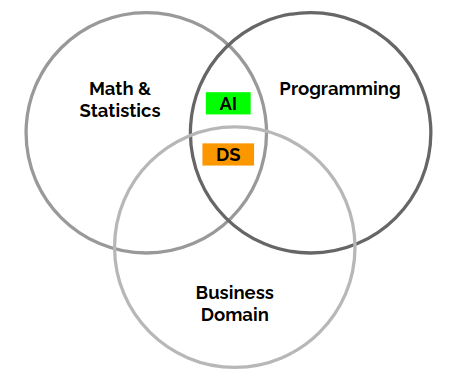Opportunities in Artificial Intelligence and Data Science Markets
Data Science , Artificial Intelligence , Machine Learning and Deep Learning
We live in a world where everything is related to data. Advance in Big Data technology leveraged the massive use of data in applications, simultaneously together with advance in computer processing capabilities and storage, analytical operations on data became much easier. This advance created fertile soil for the field: Data Science (DS). Data Science is the algorithms that identify patterns and help humans better understand the data. Indeed, it is an entire branch (or science) dedicated to better data interpretation. This interdisciplinary field is interested in retrieving information from data, structured and unstructured, and create insights to drive decisions.
Commonly used in Data Science and sometimes even mistaken by, is Artificial Intelligence (AI). Artificial Intelligence is the field of Computer Science that tries to mimic human intelligence to perform different tasks. AI includes Machine Learning and Deep Learning subdomains.
Machine Learning is the subarea of Artificial Intelligence in which programs use statistical methods to learn from data without being directly programmed. For example, programs map and predict inputs in regression and classification problems, and output numbers or classes respectively. On the other hand, Deep Learning is the subarea in which programs learn on their own to drive decisions from the data. Deep learning can mimic some human capabilities of the brain, for example, CNN's can imitate the vision or sight, while RNN implements algorithms to copy our memory capability.
Prerequisites and From Where to start
Prerequisites
While you don't need a specific degree to start your machine learning career, familiarity with STEM subjects would help a lot. In fact, it is possible today to be exposed to AI with almost no mathematical background, but technical skills such as mathematics/statistics and programming are essentials to make you shine in the field. In AI you will need more algorithms and programming skills, on the other side in DS business acumen will make the difference. Python is key programming language for both bases. It has a lot of built-in libraries that implement machine learning algorithms with single line code. In Data Science, structured query language (SQL) is needed in addition.
From Where to Start?
Well, it depends if you would like to dig into theory or start coding from day one.
I'm a practical person: Then Fast AI is an excellent choice. They are free practical courses that skip deep mathematical concepts. You start directly by training your machine learning models, creating applications, and deploying them. Another option is to join Udacity, where they have courses from industry leaders covering mathematical concepts intuitively and more focused on applications.
I would like to start with theory: You will develop a solid mathematical foundation with some practical knowledge using Coursera. Mixing good theory with practical examples, they have multiple credential courses from Top-tech companies as Google and IBM.
Confused between both categories, Udemy is a good choice. It delivers meaningful content with a low budget. Make your own curriculum having both theoretical and practical lessons from industry savvy for a very affordable price and time.
Artificial Intelligence applied in real life
Nowadays technology is so integrated into our daily lives that sometimes we can't even notice. The simple spam detector from your email account is a Machine Learning application.
One of the coolest examples of AI applied is Autonomous Vehicles. Right away you think about the Perception system, where AI is used to identify objects, people, and signs using computer vision. Without the advances in Deep Learning, processing such a large amount of da and taking precise decisions would be simply impossible
Another example of integrated technology in our lives is Chatbots. Virtual assistants can be found in our phones and business, automating customer support. They are commonly used in websites at first, and sometimes in indirect interaction with consumers.
In the agriculture field, autonomous tractors are a reality for a couple of years already. Crop type identification using satellite images also helps farmers and the government monitor, plan and increase harvest productivity, and this is only possible in large scale using AI.
Data Science and Artificial Intelligence are vastly used in the e-commerce and marketing branches. It does not only improve margins but create a better overall customer experience.
The Artificial Intelligence Market
Knowing how it works and how AI and DS can leverage the applications in our daily lives, you may be wondering how to profit from this technology. When starting a firm there are couple of things to consider and one of the main question to be asked is: How my firm will generate value for the society and other companies?
Sectors with the biggest revenues
AI adoption is a world phenomenon. A study from McKinsey and Co. shows that 74 percent of the companies that have adopted or plan to adopt AI will double their AI investment in three years. The same study shows that AI is helping companies to reduce costs and grow their profit margins. All eight business branches reported benefits from adopting AI. They are Marketing and Sales, Products and Services, Supply-chain, Manufacturing, Service operations, Finance, Risk, and HR.
Revenue and Cost improvement from AI adoption. Source: McKinsey Survey: Global AI Survey: AI proves its worth, but few scale impact
From this survey we can see two big opportunities to apply AI: decreasing costs in the Manufacturing branch and increasing revenue in Marketing and Sales. With the manufacturing and supply-chain management leading the cost reduction through AI applications, creating solutions that optimize yield or logistics-network could be very profitable. On the other side, helping Marketing and Sales companies with better pricing, recommendations systems, and customer analytics would have more adoption than in HR. A practical example in the Marketing sector is using AI to analyze customer behaviors and direct marketing campaigns to the customer segmentation that is more likely of buying the products. Thus , increasing the revenues and cutting off the cost expenses that target wrong market segment. To sum up, both sectors have tested how AI can optimize their business.
AI Market Worldwide
This market's largest area is AI Software, which accord to the International Data Corporation (IDC) is responsible for 80% of the total 156 billion dollars sector revenue in 2020. IDC also shows that AI applications are the most profitable area, leveraging CRM and ERM technologies. While AI software platforms have a small share of this pie.
With an estimated $733.7 Billion Market Size in 2027, Grand View Research project a 42.2% annual growth in the AI market size from 2020 to 2027. Artificial Intelligence startups are trying to solve the more diverse problems around the world and raising tons of money in the process. CBInsights reports that startups raised 7.2 billion during the Q2 of 2020. Even during the corona pandemic, this number reflects that 43 countries were investing in Artificial Intelligence.
According to Crunchbase, in 2019 the average funding AI Startups received was $14.6 million. Still in 2019, AI driven platform to rent vacation home called Vacasa, raised an incredible $319 M during a Series C round to develop its ideas further. AI startups have indeed a lot of potential, Tom Siebel reveals last year that his AI startup just did 160 million in annual revenue.
When we take a look at such numbers, it is not a surprise that big companies like Apple and Amazon have been acquiring AI business. In 2020 Apple bought xnor.ai for 200 million dollars, a startup that applies computer vision and machine learning to edge devices. In June Amazon acquired Zoox, an autonomous driving startup after they have raised more than 1 billion in funding. The list goes on with Microsoft, Cisco, Snap and Accenture, showing that big companies buy established solutions instead of developing from scratch.




